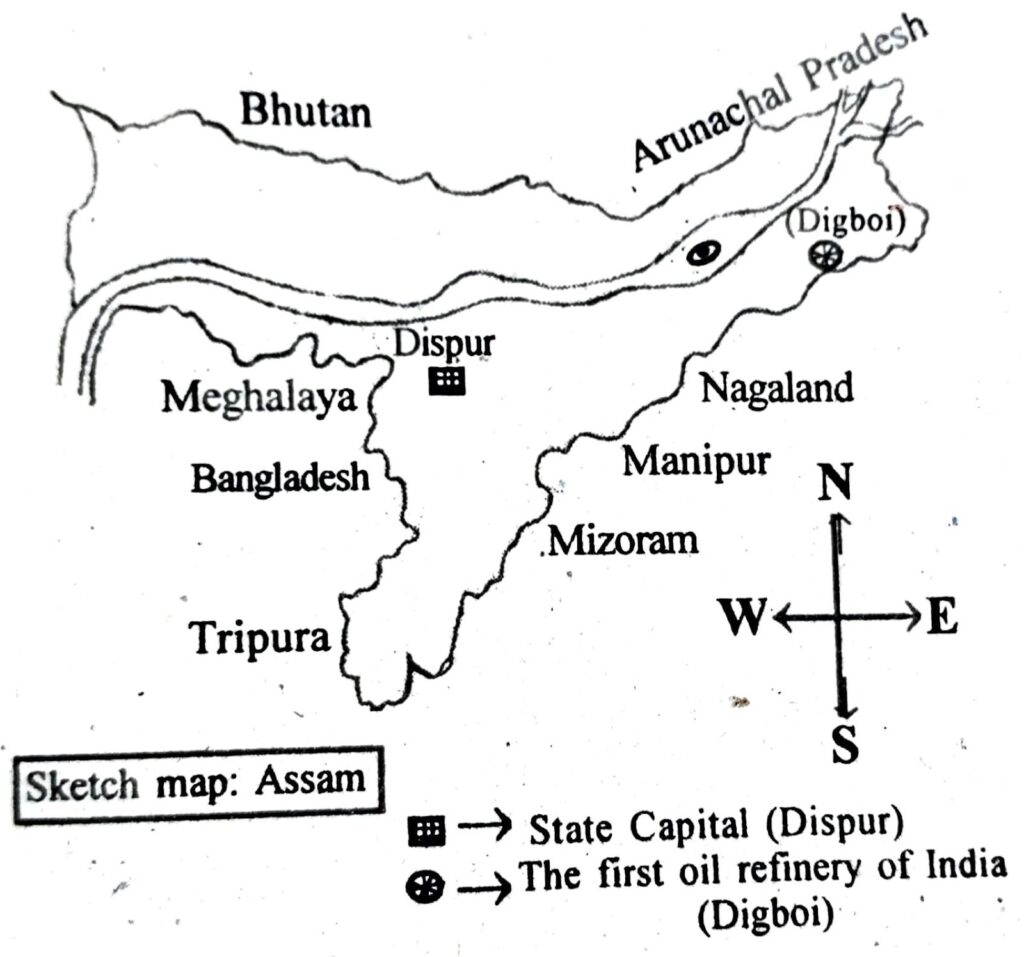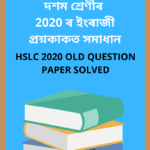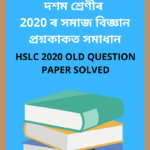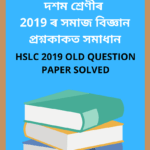SEBA Class 10 Social Science Question Paper Solved 2023 English Medium, SEBA Class 10 Social Science Question Paper Solved PDF Download, HSLC 2023 Social Science Question Paper Solved 2023 to each Paper is Assam Board Exam in the list of SEBA so that you can easily browse through different subjects and select needs one. Assam Board HSLC 2023 Social Science Previous Years Question Paper Solved can be of great value to excel in the examination.

SEBA Class 10 Social Science Question Paper Solved 2023
HSLC Old Question Paper provided is as per the 2023 Assam Board Exam and covers all the questions from the SEBA HSLC 2023 Question Paper. Access the detailed SEBA Class 10 Social Science Old Question Paper Solved provided here and get a good grip on the subject. Access the HSLC 2023 Social Science Old Question Paper Solved, Class X Social Science 2023 Old Paper Question Answer of English in Page Format. Make use of them during your practice and score well in the exams.
SOCIAL SCIENCE
2023
SOCIAL SCIENCE OLD PAPER
ALL QUESTION ANSWER
| SECTION – A |
1. Choose the correct answer of the following questions:
(i) During which British Viceroy’s period the Partition of Bengal took place?
(a) Lord Curzon.
(b) Lord William Bentinck.
(c) Robert Clive.
(d) Lord Warren Hastings.
Ans: (a) Lord Curzon.
(ii) Between whom was the treaty of Allahabad signed?
(a) between Shah Alam and Lord Curzon.
(b) between Bahadur Shah and Lord Curzon.
(c) between Shah Alam and Robert Clive.
(d) between Bahadur Shah and Robert Clive.
Ans: (c ) between Shah Alam and Robert Clive.
(iii) The Rowlatt Act was passed in the year:
(a) 1916
(b) 1917
(c) 1918
(d) 1919
Ans: (d) 1919
(iv) The Jaintia Revolt of 1861 was led by:
(a) Tikendrajit.
(b) Sambhudhan.
(c) Ukiang Nongbah.
(d) Piyoli Phukan.
Ans: (c ) Ukiang Nongbah.
(v) The oldest and the first public university of North-East India is:
(a) Dibrugarh University.
(b) Assam University.
(c) Guwahati University.
(d) Tezpur University.
Ans: (c ) Guwahati University.
(vi) The govt. recognised Classical Dance form of Tamil Nadu is:
(a) Kathakali.
(b) Kuchipudi.
(c) Kathak.
(d) Bharatnatyam.
Ans: (d) Bharatnatyam.
(vii) Which of the following is not a primary occupation?
(a) fishing.
(b) forest resource collection.
(c) manufacturing process.
(d) agricultural activity.
Ans: (c ) manufacturing process.
(viii) Which of the following is not applied to ‘resource’?
(a) cannot be exchanged.
(b) dose not have market value.
(c) brings about human welfare.
(d) may have both utility and harmful effects.
Ans: (b) does not have market value.
(ix) What is the amount of Carbon di-Oxide in atmosphere?
(a) 0.0035%
(b) 0.035%
(c) 0.35%
(d) 3.35%
Ans: (b) 0.035%
(x) Which of the following gases in the atmosphere causes acid rain?
(a) Argon.
(b) Carbon Monoxide.
(c) Nitrogen.
(d) Sulphur di-Oxide.
Ans: (d) Sulphur di-Oxide.
2. Choose the correct answer:
(i) According to census of India of 2011 what percentage of India’s population live in Assam?
(a) 2.39%
(b) 2.79%
(c) 2.60%
(d) 3.6%
Ans: (c ) 2.60%
(ii) The first stream of human migration to Assam was –
(a) The Austric group of people.
(b) The Tibeto-Burman language speaking Mongoloids.
(c) The Ahoms.
(d) The Koch Rajbongshi.
Ans: (a) The Austric group of people.
(iii) Through the 42nd constitutional amendment of 1976 three important words were incorporated in the preamble of the Indian constitution. These words are –
(a) Sovereign, Republic, Unity.
(b) Socialist, Secular, Unity.
(c) Democratic, Republic, Unity.
(d) Secular, Sovereign, Unity.
Ans: (b) Socialist, Secular, Unity.
of and 3000 national
(iv) The number of permanent member states in the security council of the UNO is five (5). Four among these are USA, Great Britain, France, China. The fifth permanent member state is –
(a) India.
(b) Russia.
(c) Nepal.
(d) Pakistan.
Ans: (b) Russia.
(v) The government of India Act, 1935 –
(i) Introduced federal system in India.
(ii) Introduced a parliamentary form of government in a limited form in.
In perspective of the above two statements, the correct alternative is:
(a) Both (i) and (ii) are correct.
( b) Both (i) and (ii) are incorrect.
(c) Only (i) is correct.
(d) Only (ii) is correct.
Ans: (c) Only (i) is correct.
(vi) In India, the Chairman of the National Human Rights Commission is to be:
(a) Chief Justice of the Supreme Court.
(b) Chief Justice of the High Court.
(c) Retired Chief Justice of the Supreme Court.
(d) Retired Chief Justice of High Court.
Ans: (c) Retired Chief Justice of the Supreme Court.
(vii) Which of the following financial institutions was made operational since 1990 to promote modernisation, expansion and to create markets for the products of the small industries in India?
(a) National Bank for Agriculture and Rural Development (NABARD)
(b) Small Industries Development Bank of India (SIDBI)
(c) Regional Rural Banks (RRRs)
(d) Life Insurance Corporation of India (LICI)
Ans: b) Small Industries Development Bank of India (SIDBI).
(viii) The five stages in the process of evolution of money are:
(a) Paper money → Coinage → Metallic Standard → Animal Standard → Barter System.
(b) Barter System→ Animal Standard→Metallic Standard → Coinage → Paper Money.
(c) Barter System→Paper Money→ Metallic Standard→Animal Standard→ Coinage.
(d) Animal Standard → Metallic Standard → Coinage → Barten System → Paper Money.
Ans: (b) Barter System→ Animal Standard→Metallic Standard → Coinage → Paper Money.
(ix) The duration of a financial year in India is:
(a) January 1 to December 31
(b) February 1 to January 31
(c) March 1 to February 28/29
(d) April 1 to March 31
Ans: (d) April 1 to March 31
(x) Identify the main objectives of Indian economy during the period of Five Year Plans from the alternatives given below:
(i) To remove socio-economic and regional inequalities
(ii) To attain self-reliance
(iii) To raise the rate of economic growth.
(iv) To remove poverty.
(a) (i), (ii), (iv)
(b) (i), (iii), (iv)
(c) (i), (ii), (iii), (iv)
(d) (i), (ii), (iii)
Ans: (c) (i), (ii), (iii), (iv)
3. Answer the following questions in short:
(i) Name the Congress representative who participated in the Second Round Table Conference of 1931.
Ans: Mahatma Gandhi.
(ii) Who led the Revolt of 1857 in Assam?
Ans: Maniram Dewan.
(i) Who was the first editor of ‘Jonaki’?
Ans: Chandra Kumar Agarwala.
(iv) Who wrote ‘Arthashastra”?
Ans: Kautilya.
(v) Name the smallest ocean in the world.
Ans: Arctic Ocean.
(vi) Name the least densely populated district of Assam.
Ans: Dima Hasao.
(vii) Which yarn of Assam is famous in the word as ‘Golden Silk’?
Ans: Muga silk.
(viii) Who presided over the first meeting of the Constituent Assembly which was formed for the preparation of the constitution of India?
Ans: Dr Sachidanand.
(ix) What is called Current Deposit?
Ans: Current deposit is a system by commercial banks collecting savings. In this system, there is a provision for the depositor to withdraw the money by cheque at any time of his needs by the depositor.
(x) Who is the Chairman of NITI Aayog?
Ans: Prime Minister Narendra Modi.
4. Fill in the blanks choosing the correct answer from the alternatives given in brackets:
(i) The demand of complete independence was raised in the ____________ session of the Congress. (Karachi/Madras/Calcutta/Lahore)
Ans: Lahore.
(ii) The British officer who died at the hands of public in the Phulaguri Dhawa Revolt was ____________. (Lieutenant Singer/McCabe/J.D. Anderson / Herbert Sconce)
Ans: Lieutenant Singer.
(iii) The International Yoga Day is celebrated on ____________. (21 June/5th June/27th June/30th June)
Ans: 21 June.
(iv) World Environment Day is celebrated on ____________. (22nd March/22nd April/5th June/5th September)
Ans: 5th June
(v) The boundary between North America and South America is formed by the ____________. (Red Sea/Panama Canal / Mediterranean Sea / Ural Mountain)
Ans: Panama Canal.
(vi) The total area of Assam is ____________ sq. km. (78,438/78,428/78,458/78,448)
Ans: 78,438.
(vii) ‘The United Nations Organisation’ was born on ____________ October, 1945. (21/22nd/234/24th)
Ans: 24th.
(viii) ____________ is not a characteristics of money. (General acceptability /Homogeneity /Liquidity / Easily Perishable good)
Ans: Easily Perishable good.
(ix) The First Five Year Plan in India began in the year ____________. (1948/1949/1950/1951)
Ans: 1951.
(x) The process in which the benefits of economic growth and development is ensured to each and every section of people in the society is called ____________. (commercialisation / globalization / financial inclusion / liberalisation)
Ans: financial inclusion.
5. Write whether the following are true of false:
(i) Leeladhar Barua was the Assamese who participated the Dandi March of Gandhi.
Ans: true.
(ii) The book ‘Hastibidyarnava’ was written by Mahapurush Sankardeva.
Ans: false.
(iii) The Andes is the longest mountain range in the world.
Ans: true.
(iv) The full expanded form of CTBT is Comprehensive Test Block Treaty.
Ans: false.
(v) The issue of paper currency in a country is the monopoly right of the Central Bank
Ans: true.
| SECTION – B |
6. Briefly discuss the contribution of Swadeshi Movement towards national education.
Ans: The Swadeshi movement not only contributed immensely to national education but also to the boycott of foreign goods. Satish Chandra Mukhopadhyay, in collaboration with Rabindranath Tagore and Charudas Bandopadhyay, formed a national event called ‘Don Society’ and instilled patriotism among the student community. The society started a movement to actively build national education in a complete manner against the University Of Karjon’s Legal Guidelines. On August 5, 1905, Rabindranath Tagore delivered a Gyanagarbha Lecture on the Need for National Education at a public meeting in Calcutta. The next day, in the presence of a large crowd, he established the national educational institution called ‘Bengal National School’. The second national school was established in Rangpur on November 8. National schools were established in several parts of Bengal due to the gradual increase in the number of students dropping out of government schools. On March 11, 1906, at a meeting chaired by Rashbihari Bose at the Town Hall in Calcutta, the top program of national education called ‘National Education Council’ was formed. The Bengal National College was established on August 15 that year.
During the Swadeshi movement, a total of 62 secondary and 3,000 primary national schools were established. Bengal Technical Institute was founded with the financial assistance of renowned barrister Taraknath Palit. The event later emerged as Jadavpur University. On the pattern of national university, ‘Bihar Vidyapith’ was established in Patna, ‘Samarth Vidyalaya’ in Maharashtra and ‘Gujarat School’ in Gujarat.
7. What were the positive and negative aspects of the Non-Cooperation Movement?
Ans: The positive aspects of the non-cooperation movement are-
(i) Due to the Non-Cooperation Movement, a Swadeshi movement was formed through the advancement of hand-spinning and weaving.
(ii) The efforts to eradicate untouchability among Hindus, the unity of Hindu-Muslims, the eradication of drugs, etc. can be said to be the contribution of the Non-Cooperation Movement.
The downside of the non-cooperation movement is-
(i) To boycott the Legislative Council, the Courts and the Government Educational Institutions.
(ii) Various awards received from the British Government and Relinquishing the title.
OR
Write a brief note on the Jallianwala Bagh Massacre.
Ans: On 10th April 1919, two nationalist leaders- Dr Saifuddin Kitchlew and Dr Satya Pal were arrested in Punjab under the infamous Rowlatt Act. On 13th April 1919, people gathered in a small park in Amritsar which was called the Jalllianwala Bagh, to protest against these arrests. The peaceful gathering was attended by men, women and children. General Dyer, a British military officer, stationed a regiment of soldiers at the only entrance of the park, declared the meeting illegal and without warning ordered his soldiers to fire. The firing lasted for ten minutes, till all the ammunition was exhausted. More than a thousand people were killed and over twice that number wounded. The massacre was worth calling genocide and it stunned the entire country. On 30th May 1919, Rabindranath Tagore renounced his knighthood. Gandhi returned the Kaiser-i-Hind Gold medal given to him for his work during Boer War.
8. Discuss in brief the importance of the revolt of 1857 in Assam.
Ans: The revolt of Assam in 1857 is a remarkable event in the history of Assam. Although the revolt failed to drive the British out of Assam, it had a far-reaching impact on Assam and its people.
The importance of this rebellion is mentioned below:
(a) Assam became a part of the National Movement: Assam’s participation in the revolt of 1857 was the first in which the people of Assam joined the rest of India to drive the British out of the country and thus became a part of the national independence movement.
(b) Ideological Example: After the revolt of 1857, from 1860 to 1894, many peasant revolts took place in different parts of the state. The death of Maniram Dewan and Piyoli Baruah inspired the masses. And many historians consider the peasant revolts that began in Assam to be a reaction to the revolt of 1857.
(c) Establishing unity among Hindu Muslims: Prominent personalities from both Hindu and Muslim communities played the role of the main organizers of the revolt. This unity not only increased the spirit of nationalism but also ushered in communal harmony in the state.
9 Give an account on the role of Assam in the Quit India Movement.
Ans: The Quit India Movement was the definitive freedom movement of India’s Independence struggle.
In Assam, the Quit India Movement took place at Kamrup, Nagaon, Darrang, Sivasagar, Golaghat, and Barpeta. Assam witnessed an unmatched game of tears and blood during the 1942 Quit India Movement. For the first time, the role of Assam in the independence movement came to the fore. Several Assamese women, who were members of the Mrityu-Bahini or Santi-Sena were the backbone of the movement.
Here are some of the freedom fighters from Assam who played a significant role in the Quit India Movement: Kushal Konwar, Hem Barua, Maniram Dewan, Bhogeswari Phukanani, Kanaklata Baruah.
Or
Write the objectives and activities of Jorhat Sarbajanik Sabha
Ans: The main objectives of the Jorhat Public Meeting were-
(a) To inform the Government about the hopes and aspirations of the people.
(b) To explain the objectives and policies of the Government to the people and (c) to improve the condition of the people.
The meeting actively raised its voice against government diplomacy.
Some of the notable activities taken by the Meeting in this regard are:
(a) In 1886, he protested against the land revenue system of the government.
(b) In 1892-93, the Sabha, together with the farming community, opposed the increased taxation.
(c) In 1893, the Sabha submitted a memorandum to the Royal Kani Commission requesting for the gradual lifting of kani from Assam.
10. Mention three factors that create unity among diversity in Indian Culture.
Ans: Indian culture can be said to be an unprecedented combination of unity in the midst of disunity.
The three factors are-
(i) Hinduism has its own pluralism and generosity.
(ii) Created by the empires formed at different times
History of Political Unity.
(iii) Religious and cultural generosity of the rulers of different eras.
Or
Write a short note on the Vaishnavite Literature of Assam.
Ans: The Vaishnavite literature is primarily composed in the Assamese language and includes works like the Kirtan Ghosa, the Naam Ghosa, and the Bhaona. These works mainly revolve around the life and teachings of Lord Krishna and are written in a simple and easily understandable style.
11. Write the Economic Geography? Mention three major branches of Economic Geography.
Ans: Economic geography is the study of the spatial distribution of economic activity and economic development. Because so much of our daily lives revolve around economic transactions, great and small, economic geography is a critical subset of human geography.
The major branches of economic geography are:-
(i) Industrial Geography: This section studies the economic and other factors involved in the establishment of industries, types and geographical distribution of industries, production of industrial goods, sources related to industry location, industrial goods market as well as import-export etc.
(ii) Agriculture Geography: Agricultural geography deals with the factors associated with agricultural activity, types of agriculture, distribution and methods of agricultural work, production of crops and the formulas associated with it, the market and import and export of agricultural products, etc.
(iii) Transport geography: It studies the type of transport system and its associated factors, the role of transportation in the distribution of resources, the role of transportation in human transportation and economic activities, economic development, etc.
12. What types of problems can be created by global warming? Give four examples.
Ans: Global Warming: Its Effects and Impacts The major impacts of global warming include societal, economic, and health impacts. It can cause a lot of harm if it continues the same way as it is happening now. Here are its certain impacts:
(i) Rise in Temperature Leading to Ice Melt: Melting glaciers and snow melts will cause severe water shortages and droughts with higher frequencies giving way to heatwaves and extreme weather conditions in the mid-latitudes. Thinning ice of the northern seas will make the atmospheric conditions vulnerable to control.
(ii) Ecological Risks: Global warming has contributed to the extension of drier climatic zones such as deserts in the subtropics. Mostly ecosystems and animal life will be affected by higher carbon dioxide levels and global temperatures leading to climate change, which will result in the extinction of many species and reduced ecological diversity.
(iii) The Threat to Marine Life: Global warming can lead to the destruction of marine and coral life underwater. Higher content of carbon dioxide in the water inflicts damage to valuable natural resources.
(iv) Loss of Settlements: Global warming can also lead to Inundation from sea level rise, which can further threaten infrastructure and establishments of human settlements. This severely leads to a decrease in the human population. Droughts, temperature rise, loss of glacial rivers puts the state of agriculture on ain the rampage.
13. Briefly describe the earth’s lithosphere and hydrosphere.
Ans: The total land area of the world is about 510 million square kilometers. Of this, only 29% i.e. 149 million square kilometres are covered by land. This part of the world is made up of asia, africa, north america, europe, south america, oceania, and antarctic continents. On the other hand, 71% of the world’s total land area, or 361 million square kilometers, is covered by water. It is bordered by the Atlantic Ocean, the Pacific Ocean, the Northern Ocean, the Indian Ocean, and the Southern Ocean.
Or
Briefly discuss the Physical Characteristics of Asia.
Ans: The natural features of the Asian continent are important and unparalleled.
These features are given below—
(a) Mountainous and plateau regions: This continent is covered by high mountain ranges and plateaus. The central part of the continent is full of mountains and plateaus. The Himalayas, the world’s tallest mountain range, are located on this continent. Moreover, the Karakoram, Tienshan, Aravali mountains of this continent are particularly notable. On the other hand, this continent is home to the highest of the world, the plateaus of Palmir as well as the plateaus of Tibet, the Deccan, Siberia, etc.
(b) Peak: Mount Everest, the world’s highest peak under the Himalayan mountain range, and Mount Godwin Austin (part of the Karakoram Mountain), the second highest peak in the world, is located on this continent.
(c) Rivers and River Valleys: There are numerous small and big rivers like Indus, Ganga, Brahmaputra, Obi, Lena, Huangho etc. on this continent. Moreover, the continent is home to the world’s most populous regions such as the Ganges, Yamuna, Brahmaputra Valleys.
(d) Sea Islands and Lakes: Small islands like Japan, Philippines, Sumetha, Java, etc. are located in the Pacific and Indian Oceans. In addition.
14. Mention the Problems of agriculture department in Assam.
Ans: The problems of agricultural development in Assam are:
(i) Traditional agriculture in the plains of Assam and jhum cultivation in the hilly areas is still going on in the traditionally old ways.
(ii) It is difficult to apply modern agricultural implements and techniques to the cultivated lands of the farmers of Assam, which are generally divided into smaller sections.
(iii) Irrigation system is not improved and irrigation facilities are not adequateǀ
(iv) Assam is widely done and its importance is more in the agricultural economy but the application of modern farming methods for the improvement of this cultivation has not been emphasized.
(v) Assam’s agriculture has been damaged by floods and erosion, more than 25 per cent of the total cultivated land in the state is damaged by the yearly floods and a large amount of fertile soil is submerged in the river every year due to erosion.
Or
Briefly discuss the causes responsible for variation in the distribution of Assam’s population with examples.
Ans: There are many important which are responsible for the variation distribution of the people in Assam.
These are:
(i) The physical environment of the place.
(ii) The developed economy.
(iii) Economic and transport system.
(iv) Social and cultural factors etc.
The Brahmaputra and Barak Valley are thickly populated due to its:
(i) Plain land.
(ii) Fertile soils. and
(iii) Favourable condition for economic development such as agricultural and transport system and communication facility. Because of all these facilities about 85% population of Assam live in the Brahmaputra valley.
According to the 2011 census, the density of population 371 in upper Brahmaputra, 500 persons in middle Brahmaputra and 631 persons in lower Brahmaputra. On the other hand, Borak Valley also densely populated because of its fertile plain land with favourable conditions for transport and communication and agricultural production. The density of population is 545 persons in the valley.
15. Draw a Sketch map of Assam and locate therein any two of the following with names:
(a) The oldest oil refinery of India
(b) The Head Quarters of North-East Frontier Railway
(c ) The largest tea garden of Assam
Ans:

Or
| For Blind Candidates Only |
Write briefly about the water resources of Assam.
Ans: Assam has extensive and boundless water resources, the large unending and everlasting rivers and many other water bodies with rich aquifer. Assam is rich in surface ground water resources due to high rainfall, numerous perennial rivers, thousand of wetlands, etc.
The two main rivers, the Brahmaputra and Barak rivers, carry huge amount of water. These two rivers with their tributaries amount to almost one-third of the water resources of the country. Besides there are some large and small marshes and ponds all over the state.
In the plains, the range of underground water level in 5 metre from the surface. It is also utilised for Agriculture, industrial and domestic purpose. However, it is to be noted that water resources are not fully utilised in the state and a lot more can in this regard.
A part from the rain water received, the state is endowed with number of perennial rivers and lake locally known as beel. The state is drained by the dance networks of two river system, viz the Brahmaputra and the Barak. These rivers have large number of tributaries joining them from both the banks.
16. Write Briefly the characteristics of the Indian Federal System.
Ans: The features of the United States system of India are:
(a) In the United States system of India, many features of monocentric government remain singular. That is why the framers of the Constitution have called it ‘united states in structure but monocentric in ideology’.
(b) In the United States system of India, organ states do not have the right to withdraw.
(c) for the Constituent States in the United States of India
There is no provision of a separate constitution. There is only one Constitution for the whole of India and that is the Constitution of India.
(d) There is no provision for dual citizenship in the United States system of India. Here a citizen is known only as a citizen of India.
Or
From which country’s constitution the concept of India’s parliamentary democracy is followed? Mention two differences of the parliamentary democracy system of India as compared to that country.
Ans: The Parliamentary System of government in India is taken from the British(UK)constitution.
The two differences of the parliamentary democracy system are:
(i) The parliamentary system of government in India is largely based on the British parliamentary system. However, it never became a replica of the British system and differs in some respects.
(ii) The British system is based on the doctrine of the sovereignty of Parliament, while the Parliament is not supreme in India and enjoys limited and restricted powers due to a written Constitution, federal system, judicial review and fundamental rights.

Hi! my Name is Parimal Roy. I have completed my Bachelor’s degree in Philosophy (B.A.) from Silapathar General College. Currently, I am working as an HR Manager at Dev Library. It is a website that provides study materials for students from Class 3 to 12, including SCERT and NCERT notes. It also offers resources for BA, B.Com, B.Sc, and Computer Science, along with postgraduate notes. Besides study materials, the website has novels, eBooks, health and finance articles, biographies, quotes, and more.









